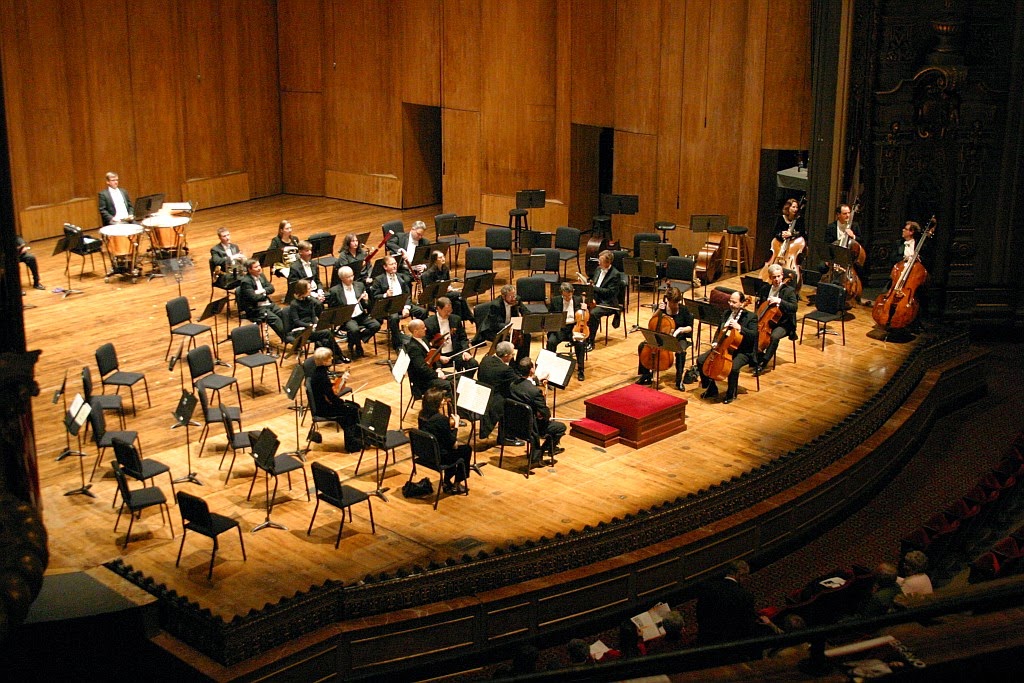 |
| Columbus Symphony musicians warming up before a concert |
For quite some time I've harbored the notion
that concert hall acoustics may be improved by electronic means. While many
classical musicians regard themselves as purists who frown upon electronic
enhancement, I consider myself more of a realist. Let's face it - some concert
halls disappoint. If a professional orchestra performs in a dull hall, then no
matter how well that orchestra plays, it won't sound all that impressive. An
orchestra needs an acoustical environment capable of supporting and enhancing
its sound. The absence of such a venue surely affects public support for the
orchestra. If the public leaves the concert hall feeling inexplicably
unsatisfied, how likely is it that the audience will return for another
performance or write donation checks? Since musicians and concertgoers alike
seem unaware of the issue of acoustics, the source of aural disappointment is
perhaps unaddressed or, worse, attributed to the orchestra itself.
Yet many classical musicians bristle at the notion of amplification, as if the
inherent acoustics of the hall, no matter how inadequate, may be somehow
trumped by each individual musician's ability to produce a glorious sound! The
truth is that no matter how great an orchestra and its specific musicians are,
if the hall deadens the sound too much, the listener will experience too little
sense of presence, much like listening to a home audio system with the volume
turned down way too low. Try an experiment with your home stereo system –
starting with your volume turned down very low, gradually increase the volume
until you begin to feel satisfied with your listening experience. That
particular volume level marks the “threshold of presence". An
acoustically appealing concert hall reaches and at times surpasses that
threshold.
This past weekend the Columbus Symphony performed a pops concert in the Ohio
Theatre which featured the orchestra alone during the first half of the
concert. After intermission ABBA the Concert (a tribute band from
Sweden) took the stage with the orchestra, with amplification. For this
particular concert, the orchestral first half was also mildly amplified, and
the portable shell was removed from the stage. During the rehearsal, several
Columbus Symphony musicians seemed dismayed by the shell removal and
amplification. The reasoning was that the missing shell would have provided
much-needed sound reflection, and the amplification was, as usual, summarily
dismissed as an affront to our artistic sensibilities.
After listening to the complaints of my fellow musicians, I decided to venture
out into the audience seating area of the hall during the rehearsal to see how
the orchestra actually sounded from the audience perspective. I was stunned!
Never before had I heard the Columbus Symphony sound so luxuriant in the Ohio
Theatre. Indeed, the electronic amplification helped the orchestra to fill
the cavernous hall with its now-massive sound, finally crossing over the hitherto
elusive "presence threshold”. The portable shell which so many of the
musicians deemed indispensable had been upstaged by a few microphones!
The audience responded to our performance with spirited applause and cheers. (I
predict future ticket sales for these satisfied customers.) We received our first ever (as far as I know)
standing ovation for the orchestral first half of a pops concert, and the review reflected the enthusiasm of our listeners.
The current issue of The New Yorker magazine features an intriguing article about innovations in
sound control. Of course, the best option for any orchestra is to perform
regularly in a first-class concert hall with pleasing acoustics. But in the
absence of such a hall, perhaps technology may be used to make up the
difference between the actual hall and the ideal acoustical setting. Is it
possible for us classical musicians to open our minds to the possibility?
.






No comments:
Post a Comment